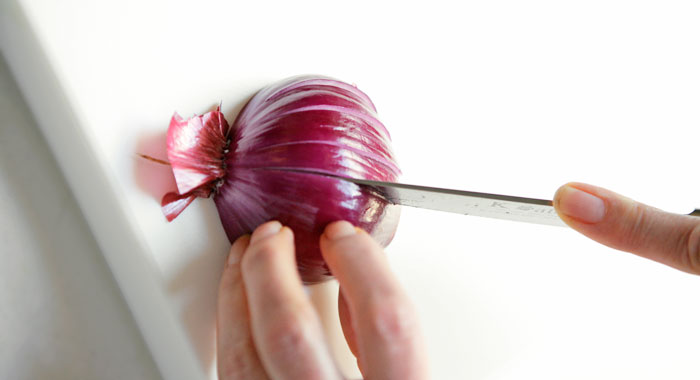
Pronounce it: un-yun
Onions are endlessly versatile and an essential ingredient in countless recipes. Native to Asia, these underground bulbs are prized all over the world for the depth and flavour that they add to savoury dishes. Dry onions are fully matured, with juicy flesh and dry, papery skin and have a pungent flavour that becomes wonderfully sweet upon lengthy cooking.
Varieties of onion differ in size, strength and colour. The yellow onion is the most commonly known variety; it has pale golden skin, greenish-white flesh and a strong taste. Red onions are an attractive, milder alternative to the yellow onion with their shiny purple skin and red-tinged flesh. Shallots are a sub-species of onion; they are small and boast a delicate flavour integral to French cooking. Spring onions are immature onions pulled before the bulb is fully formed, and can be recognised by their long green leaves. Like red onions, they are fairly mild and often used raw in salads.
When chopped, onions produce a volatile, sulphur-rich oil that makes eyes water. Over the years cooks have devised many ways to prevent this – freezing the onion; wearing goggles or holding your breath – but they are rarely completely effective. The best way is to not cut through the root of the onion, as this is where most of the oil resides.
Find out about the health benefits of onions.
Availability
Dry and spring onions are available all year-round. As a result, there is usually little need to resort to onion powder (ground dehydrated onion), onion salt (onion powder and salt), onion flakes or onion flavouring cubes, which are of inferior quality to the real thing. Pickled onions are also available.
Choose the best
Look for firm onions, with no soft spots, damp or mouldy patches. Choose from the following, according to your recipe:
White onion: medium to large in shape, with a white papery skin and evenly white flesh. They have a strong flavour and are good for stuffing or baking; only use raw in salads if you want an assertive onion flavour.
Yellow/brown onion: a good all-purpose onion, with a light golden skin and yellow flesh.
Spanish onion: has a similarly coloured skin to a yellow/brown onion, but is usually bigger, as well as sweeter and milder – good for omelettes, salsas and stir-fries.
Red onion: varies in size, but has a distinctive red/purple skin, and the edge of each of its white rings is tinged with red. The flavour is mild and quite sweet. Good for salads, marinades, salsas and roasts.
Prepare it
First slice off the top of the onion (leave the root on for the moment), then remove the papery skin and any brown outer layers. To chop the onion, cut in half from top to bottom. Put the cut side down and make a number of horizontal cuts towards, but not quite reaching, the root. Then make as many vertical cuts through the onion, again not quite reaching the root. Holding the onion very firmly and with the knife blade at right angles to the first set of cuts that you made, slice down vertically – the onion will fall away in small pieces as you go. Continue cutting until you reach the root, which you can now discard.
To slice, trim the root off, then cut in slices moving from the root end towards the top. Leave as slices or separate each one out into rings.
All onions are best prepared just before you use them.
Store it
Depending on their condition when purchased, dry onions will keep for several months. Store them in a cool, dry place (not the fridge as they will go soft). Once cut, wrap them up in the fridge and use within two or three days. Spring onions can be stored in the fridge for up to a week.
Cook it
Gently fry chopped or sliced onion (7-10 minutes) then use as the base for pasta sauces, soups and stews. Cut into wedges and roast (40-50 minutes). Cut into rings, batter and deep fry (3 minutes). Bake (20-30 minutes).
Alternatives
Try leek.
Be the first to comment on "Onion"